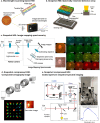Hyperspectral retinal imaging in Alzheimer's disease and age-related macular degeneration: a review
- PMID: 39363330
- PMCID: PMC11448307
- DOI: 10.1186/s40478-024-01868-y
Hyperspectral retinal imaging in Alzheimer's disease and age-related macular degeneration: a review
Abstract
While Alzheimer's disease and other neurodegenerative diseases have traditionally been viewed as brain disorders, there is growing evidence indicating their manifestation in the eyes as well. The retina, being a developmental extension of the brain, represents the only part of the central nervous system that can be noninvasively imaged at a high spatial resolution. The discovery of the specific pathological hallmarks of Alzheimer's disease in the retina of patients holds great promise for disease diagnosis and monitoring, particularly in the early stages where disease progression can potentially be slowed. Among various retinal imaging methods, hyperspectral imaging has garnered significant attention in this field. It offers a label-free approach to detect disease biomarkers, making it especially valuable for large-scale population screening efforts. In this review, we discuss recent advances in the field and outline the current bottlenecks and enabling technologies that could propel this field toward clinical translation.
Keywords: Age-related macular degeneration; Alzheimer’s disease; Hyperspectral imaging; Neurodegenerative disease; Retinal imaging.
© 2024. The Author(s).
Conflict of interest statement
Y.K. and M.K.-H. are co-founding members and consultants of NeuroVision Imaging, Inc. L.G. has a financial interest in Lift Photonics. However, neither company was involved in the research presented in this paper. Other authors declare no competing interests.
Figures






References
-
- Patterson C (2018) World alzheimer report 2018
-
- Klunk WE, Engler H, Nordberg A, Bacskai BJ, Wang Y, Price JC, Bergström M, Hyman BT, Långström B, Mathis CA (2003) Imaging the pathology of Alzheimer’s disease: amyloid-imaging with positron emission tomography. Neuroimaging Clin 13:781–789 - PubMed
-
- Jia J, Ning Y, Chen M, Wang S, Yang H, Li F, Ding J, Li Y, Zhao B, Lyu J, Yang S, Yan X, Wang Y, Qin W, Wang Q, Li Y, Zhang J, Liang F, Liao Z, Wang S (2024) Biomarker changes during 20 years preceding Alzheimer’s disease. N Engl J Med 390:712–722. 10.1056/NEJMOA2310168/SUPPL_FILE/NEJMOA2310168_DISCLOSURES.PDF - PubMed

